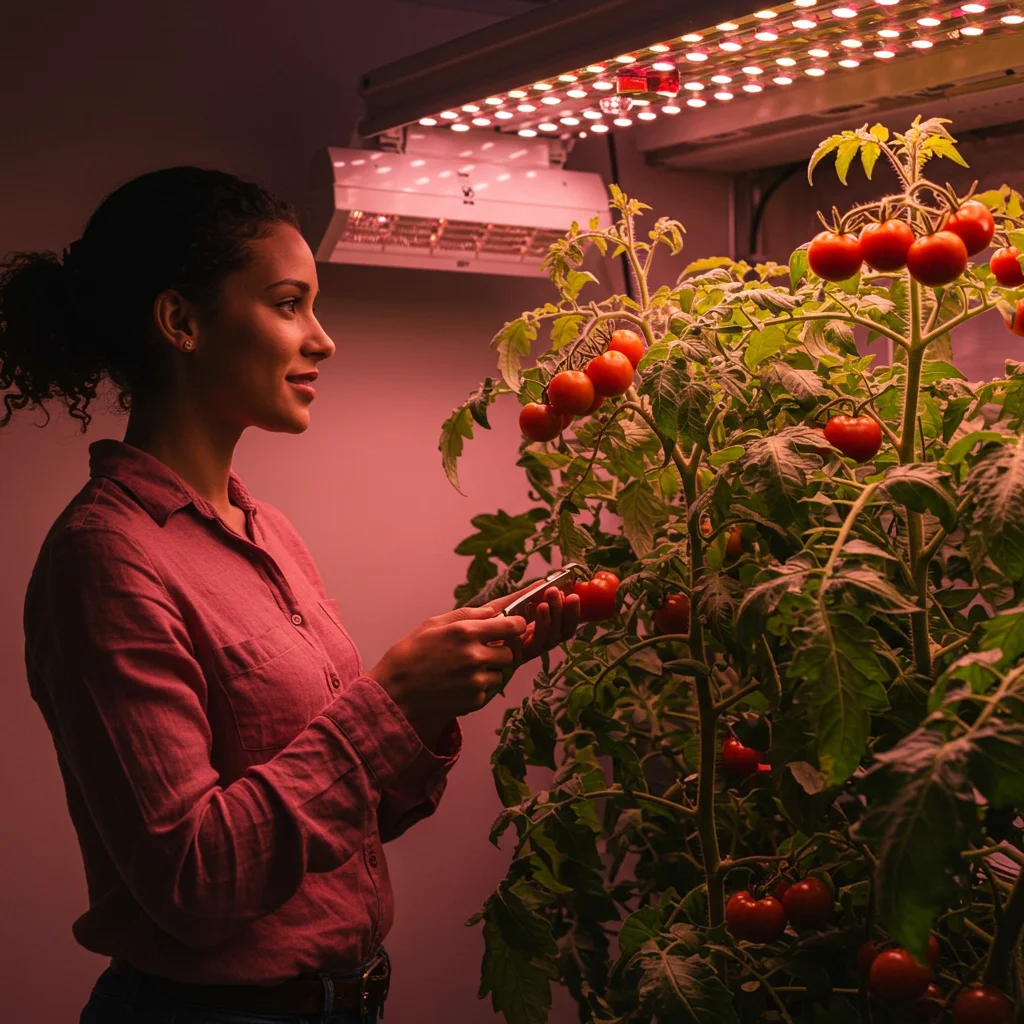This comprehensive guide explores the world of grow lights for tomato plants, covering everything from choosing the right type of light to setting up your indoor or supplemental lighting system. Learn how to use grow lights effectively to maximize your tomato yield and enjoy delicious, homegrown tomatoes year-round.
Introduction:
Growing juicy, ripe tomatoes is a rewarding experience, but what if you don’t have the ideal outdoor space or live in a climate with a short growing season? The solution lies in the power of grow lights! Supplemental or sole-source lighting can provide your tomato plants with the energy they need to thrive, regardless of the weather or your location. This guide will equip you with the knowledge and resources to choose the perfect grow lights for your tomato plants and cultivate a bountiful harvest.
JUMP TO TOPIC
Choosing the Right Type of Grow Light for Tomatoes
Selecting the right type of grow light is crucial for healthy tomato plant growth. Here’s a breakdown of the most popular options:
LED Grow Lights
- Energy Efficiency: LEDs (Light Emitting Diodes) are incredibly energy-efficient, consuming significantly less electricity than other types of grow lights.
- Lifespan: LEDs have a long lifespan, reducing the need for frequent replacements.
- Targeted Wavelengths: Modern LEDs can be customized to emit specific wavelengths of light, catering to the needs of tomato plants at different growth stages.
- Cost: While initially more expensive, the long-term savings on energy consumption and replacements make LEDs a cost-effective choice.
Fluorescent Grow Lights
- Affordability: Fluorescent lights are a budget-friendly option for beginners.
- Lower Heat Output: They produce less heat than HID lights, making them suitable for smaller grow spaces.
- Types: T5 and T8 fluorescent tubes are common choices for growing tomatoes.
High-Intensity Discharge (HID) Grow Lights
- High Light Output: HID lights, encompassing Metal Halide (MH) and High-Pressure Sodium (HPS) bulbs, produce intense light, suitable for large grow operations.
- Heat Output: HIDs generate a significant amount of heat, requiring proper ventilation.
- Spectrum Considerations: MH bulbs are generally preferred for vegetative growth, while HPS bulbs are better suited for flowering and fruiting.
Setting Up Your Grow Light System for Tomatoes
Determining the Right Distance
The ideal distance between your grow lights and your tomato plants will depend on the type and wattage of the light. Start with the manufacturer’s recommendations and adjust as needed, observing your plants for signs of light stress (e.g., leaf burn) or insufficient light (e.g., leggy growth).
Light Cycle for Tomatoes
Tomato plants require 12-16 hours of light per day. Use a timer to automate the light cycle and ensure consistency.
Reflectors and Ventilation
Using reflectors can help maximize light efficiency by directing light towards your plants. Proper ventilation is essential, especially when using high-heat output lights like HIDs, to prevent overheating and maintain optimal growing conditions.
Understanding Light Spectrum and Tomato Growth
Tomato plants, like all plants, utilize specific wavelengths of light for photosynthesis and growth. Red and blue light are particularly important:
- Red Light: Promotes flowering and fruit production.
- Blue Light: Encourages strong vegetative growth and compact plant structure.
Full-spectrum grow lights, which mimic natural sunlight, are an excellent option for tomatoes, ensuring a balanced light spectrum throughout the plant’s life cycle.
Nutrients and Watering under Grow Lights
While grow lights provide the energy for photosynthesis, your tomato plants still need essential nutrients and water. Use a high-quality potting mix and a balanced fertilizer specifically formulated for tomatoes. Water regularly, allowing the soil to dry slightly between waterings. (Learn more about tomato plant care).
Troubleshooting Common Grow Light Problems
- Leggy Growth: Indicates insufficient light intensity or too much distance between the plant and the light.
- Leaf Burn: Signals excessive light intensity or the light being too close to the plant.
- Slow Growth: Could be due to insufficient nutrients, improper watering, or inadequate light.
FAQs About Grow Lights for Tomato Plants
- Q: Can I use regular household bulbs for growing tomatoes?
- A: Regular household bulbs don’t provide the specific light spectrum required for optimal tomato growth. While they might provide some light, they won’t deliver the results you’ll achieve with dedicated grow lights.
- Q: How much do grow lights cost to run?
- A: The cost depends on the type and wattage of the light, as well as your local electricity rates. LEDs are the most energy-efficient, leading to lower operating costs in the long run.
- Q: How long do grow lights last?
- A: LED grow lights have the longest lifespan, typically lasting for years. Fluorescent and HID bulbs have shorter lifespans and require periodic replacement.
- Q: Can I use grow lights outdoors?
- A: Yes, grow lights can be used outdoors to supplement natural sunlight, particularly in areas with limited sunlight or during the off-season. (Explore outdoor growing tips)
- Q: What are the best grow lights for seedlings?
- A: Seedlings benefit from lower light intensity. T5 fluorescent lights or seedling-specific LED grow lights are good options.
Conclusion
Growing tomatoes with grow lights opens up a world of possibilities, allowing you to enjoy a fresh supply of homegrown tomatoes year-round. By understanding the different types of grow lights, setting up your system correctly, and providing proper care, you can cultivate a thriving indoor or supplemental garden and savor the delicious fruits of your labor. Choosing the correct grow light is an investment in your gardening success, so take the time to research and select the best option for your needs and budget. Happy growing!

